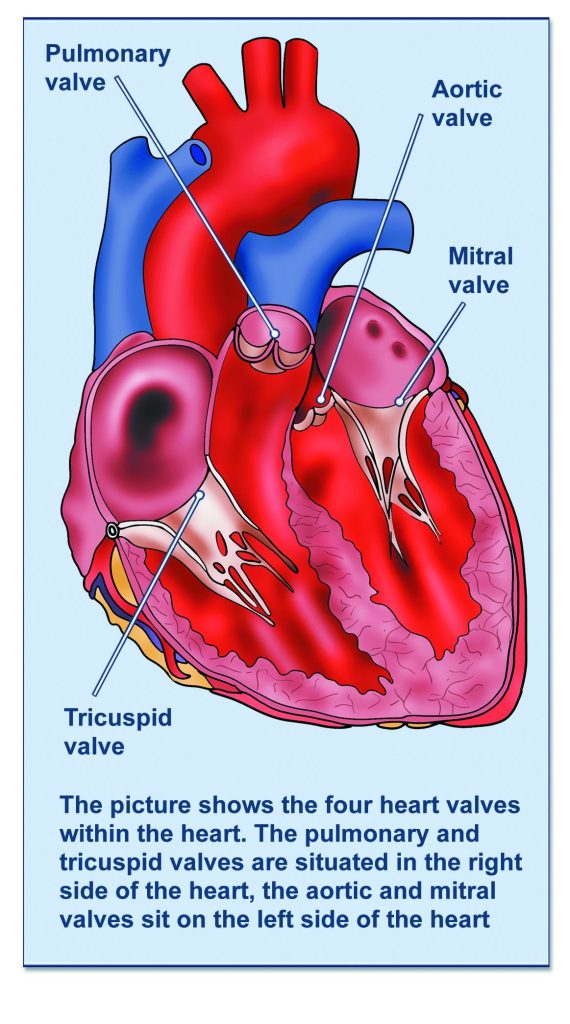
Mechanical (metal) valve
About 20% of all surgical valves used in Europe and the USA are mechanical.
A mechanical (sometimes called metal) heart valve is an artificial valve made out of carbon, a material originally developed to coat used radioactive rods taken from nuclear reactors. This material is exceptionally light and strong. Carbon is vapourized and allowed to condense on a mould or a machined piece of graphite. It is then polished to a glassy surface. It is used to make the leaflets that open and close, and also the housing inside which these leaflets pivot.
There are different designs of valve but the most common is a bi-leaflet valve where the two discs tilt to open and close each time the heart pumps and relaxes. These have been implanted now for over 50 years and are very durable designs which will often last an entire lifetime.
As these are made of artificial materials there is a risk of blood clotting on the heart valve surface. In order to prevent the blood clotting on the valves you will need to take a blood thinner medication known as warfarin for the rest of your life.
Warfarin is a very well-tolerated drug in the vast majority of patients and almost all patients manage very well with this medication. However many patients are also anxious or nervous about taking it, as regular blood tests are required for monitoring purposes. You can read more about warfarin here.
Some patients have taken warfarin for a heart condition known as atrial fibrillation (an irregular heart beat). More recently many of these patients have switched to medications known as DOAC or NOAC medications which do not require monitoring. It is important to understand that these new medications are not suitable for patients with mechanical aortic valves. Only blood thinners such as warfarin or sinthrone are suitable for patients with mechanical valve replacements.
The clicking noise from modern mechanical valves is not usually audible except sometimes when you lie on the left. It may be more obvious to a partner. If complete silence is important this could be a reason to consider a biological valve instead, although virtually all patients get so used to their clicking valve that they do not notice it after a matter of months.
Bioprosthetic (biological) valve
About 80% of replacement surgical valves are now biological.
These are usually stented which means they are made from animal tissue sewn inside a mounting frame made from a non-ferrous metal or plastic. Outside this is a fabric sewing ring to sew the valve into the space left after removing the diseased valve. The animal tissue is usually the aortic valve of a pig, or pericardium from a calf.
These have the advantage of not needing anticoagulation with warfarin but the major downside is a limited life-span. They are mainly suited to people aged over 60 in the aortic position or 70 in the mitral position. Below these ages biological valves thicken and fail more rapidly particularly under the age of 50.
Valve repair
A repair is the treatment of choice for many patients with mitral regurgitation caused by mitral prolapse. Techniques have advanced over the last 10 years and the commonest forms of prolapse should be readily repairable by a specialist surgeon.
Some situations like thickening and prolapse of both mitral leaflets may be harder to repair and your surgeon may give you an approximate percentage likelihood of this. Otherwise you will need a replacement artificial valve.
Repair involves supporting prolapsing tissue with artificial chords (made of Gore-Tex) or chords transplanted from other parts of the valve. Sometimes redundant tissue is cut out and the edges sewn together to reduce the size of the leaflet. Small holes in the leaflet can be repaired using tissue. Most repairs are completed with a ring made of plastic sewn into the base of the leaflets to restore the valve opening to a normal size and reduce the strain on the sutures.
Repair for mitral prolapse, when feasible, is preferable to replacement because it is more natural and preserves the pumping function of the heart better.
A repair – often just using a ring to gather in the neck of the valve can also be done for mitral regurgitation caused by damage to the left ventricle. It is less certain in this situation that repair is better than replacement. A valve replacement may be quicker than a repair and it is good to avoid prolonged operations which can worsen left ventricular damage.
If aortic regurgitation is caused by an enlarged aorta, then it may be fixed by replacing the abnormal aorta. Repair of an abnormal aortic valve may also be possible, but this is a highly specialised procedure and a relatively small number of patients are suitable. Long-term results are not yet known in detail.
Ross procedure
The Ross procedure is an unusual operation for aortic stenosis and aortic regurgitation. It involves taking out the diseased aortic valve and replacing it with the patient’s own pulmonary valve. The pulmonary valve is then replaced by a homograft (a donated human valve). The idea is that the important aortic valve is replaced by a fresh and hopefully still living valve while the replacement homograft valve is put in the right side of the heart. Here the pressures in the pulmonary artery and cardiac chambers are lower than on the left side so the valve fails more slowly. It is also easier to put in a valve stent on the right side as a repair than on the left-side of the heart.
The transplanted pulmonary valve may last a long time – about 20 years – and does not need anticoagulation, so can be a good option for younger people. In children it may grow as the child grows, and thus avoid the need for re-do operations with progressively larger mechanical valves. The downside is that it is complicated to perform. A small number of transplanted valves need to be revised early to obtain the desired result. It is not widely available, so if you wanted to consider this your cardiologist might need to refer you to another centre
Minimal access surgery
Most valve operations are performed via an incision in the front of the chest. This allows direct access to the heart but does obviously leave you with a scar down your breastbone which is usually around 15 cm long. This is very acceptable to most patients and not a big consideration.
Some patients do not find the idea of a scar acceptable and may be considered for minimally invasive surgery.
There are different types of minimal access surgery. A mini-thoracotomy is a small incision around 10 cm long across the right side of the chest. Through this, the surgeon is able to pass between the rib spaces and expose only the area of the aorta and heart around the aortic valve. It usually gives a scar which has a better cosmetic appearance.
Minimal access mitral valve surgery is offered in a few centres in the UK. This requires a small incision to be made in the right side of the chest just below the armpit.
Robotic surgery is only offered in a minimal number of centres in the UK. During this surgery several ports are inserted into the chest cavity via small incisions. The surgery is performed by the surgeon operating a robot. This type of surgery has the advantage of a faster recovery. Only certain patients are suitable for this type of surgery and it requires a very skilled surgeon to operate the robot. It is likely that this type of surgery will increase in the future but as of yet has not received widespread uptake.
‘Coronary artery bypass surgery’ at the same time as valve surgery
Before your valve replacement operation you are likely to undergo either a gated cardiac CT scan or a coronary angiogram to assess whether you have narrowings in the heart arteries. The heart arteries are also known as coronary arteries. These leave the main aorta and provide oxygenated red blood to the heart muscle allowing it to pump effectively.
If you have tight narrowings in your coronary arteries prior to valve surgery, it is beneficial for you to have these treated at the same time as your valve surgery. This means you will be offered an aortic valve operation with coronary artery bypass surgery.
During coronary artery bypass surgery, the surgeon will take a vein from your leg or an artery from your chest and sew it on to the coronary artery that is narrowed, effectively bypassing the narrowing.
Having a coronary artery bypass operation at the time of your valve operation will add a small amount of risk to the operation. However it is important that your coronary artery disease is treated at the same time to allow your heart to recover well following your cardiac surgery operation.
